Başta görme engelli çocuklar olmak üzere tüm masal dinlemeyi seven çocuklar için,
evdeki kitapları kurcaladım ve masal okumaya başladım.
Sesimin masal dinlemeyi seven tüm çocuklara ulaşması dileğiyle.
Beste Teacher
Başta görme engelli çocuklar olmak üzere tüm masal dinlemeyi seven çocuklar için,
evdeki kitapları kurcaladım ve masal okumaya başladım.
Sesimin masal dinlemeyi seven tüm çocuklara ulaşması dileğiyle.
Beste Teacher
Sonuçları Journal of Neuroscience dergisinde yayımlanan çalışmada, Northwestern Üniversitesi’nden bilim insanları ilk kez, nefes alış-veriş ritminin, insan beyninde duygusal değerlendirme ve hafızayı güçlendiren elektriksel aktivite oluşturduğunu keşfettiler.
Davranışlar üzerindeki bu etkiler, nefesinizi burundan ya da ağızdan alıp vermenize bağlı olarak değişiklik gösteriyor.
Çalışmada, kişiler, korkmuş bir yüzle eğer nefes alma anında karşılaşmışsalar, bu yüzü nefes verme anına kıyasla daha hızlı tanımlayabiliyorlardı.
Northwestern Üniversitesi Feinberg Tıp Fakültesi Nöroloji Anabilim Dalı öğretim görevlisi Christina Zelano, “Bu çalışmada elde edilen en önemli bulgulardan biri, nefes alma sırasında, amigdala ve hipokampusta, nefes vermeye göre daha belirgin bir beyin aktivitesi gerçekleşmesidir. Nefes aldığınızda, limbik sistemin tamamında, koku korteksi, amigdala ve hipokampusta nöronların canlandığını keşfettik.” şeklinde konuştu.
Ameliyattan bir hafta önce, krizlerinin nedenini belirlemek için 7 epilepsi hastasının beynine elektrotlar yerleştirildi. Kaydedilen elektriksel sinyaller, beyin aktivitesinin soluk alma sırasında dalgalanmalar gösterdiğini ortaya koydu. Söz konusu aktivasyonlar, beynin duygular, hafıza ve koku merkezlerinde meydana geldi. Bu bulgu, araştırmacıları, söz konusu beyin bölgeleriyle ilişkili, özellikle korku işleme ve hafıza, bilişsel fonksiyonlarının da nefes alma ritminden etkilenip etkilenmediği sorusunu sormaya yönlendirdi.
Amigdala, duygusal işleme merkezidir. Özellikle de korku ile ilişkili duygularda… Dolayısıyla bilim insanları, yaklaşık 60 kişiden, nefes ritmlerini kaydederken laboratuvar ortamında duygusal ifadeler konusunda hızlı kararlar vermelerini istediler. Katılımcılara, korku ya da şaşkınlık ifadesi gösteren yüz fotoğrafları gösterilerek, gösterilen yüz fotoğraflarında mümkün olan en kısa sürede hangi duygusal ifadenin bulunduğunu belirlemeleri istendi.
Nefes alma sırasında kişiler, korkulu yüz ifadelerini, nefes verdikleri ana göre çok daha hızlı tanımladılar. Çalışmaya katılan kişiler, ağızlarıyla nefes alırken aynı görevi yerine getirdiğinde bu etkilerde ciddi oranda azalma görüldü. Dolayısıyla, bu etkinin yalnızca burundan soluk alma ile ilişkili olduğu anlaşıldı.

Hafıza işlevini hipokampusa bağlı değerlendirmeye yönelik diğer bir deneyde ise, katılımcılara bilgisayar ekranından bazı nesnelerin resimleri gösterildi ve onları hatırlamaları söylendi. Araştırmacılar, görüntülerin nefes alma sırasında gösterilmesi durumunda daha iyi hatırlandığı bulgusuna ulaştılar.
Bulgular, hızlı nefes almanın, tehlikeli bir durum içerisindeki insan için bir avantaj olabileceğini ortaya koyuyor.
Zelano, “Eğer panik halindeyseniz solunum ritminiz daha hızlı olur.” dedi. “Dolayısıyla, sakin halinize kıyasla panik halinizde nefes almak için daha fazla süre geçirirsiniz. Böylece, hızlı nefes almayla vücudunuzun korkuya verdiği iç tepki, beyin fonksiyonlarınızda olumlu bir etkiye neden olur ve çevredeki tehlikeli uyarana karşı daha hızlı tepkiler oluşturmanızı sağlar.”
Araştırmanın bir diğer amacı, meditasyonun temel mekanizmaları veya odaklanılmış solunum üzerinde durmaktadır. Zelano, “Nefes aldığınızda, bir anlamda limbik ağı boyunca beyin salınımlarını, solunum ritminizle senkronize ediyorsunuz” dedi.
Bu çalışma, Ulusal Sağırlık ve Ulusal Sağlık Enstitüleri İletişim Bozuklukları Enstitüsü’nün R00DC012803, R21DC012014 ve R01DC013243 hibeleriyle desteklendi.
CHICAGO — Northwestern Medicine scientists have discovered for the first time that the rhythm of breathing creates electrical activity in the human brain that enhances emotional judgments and memory recall.
These effects on behavior depend critically on whether you inhale or exhale and whether you breathe through the nose or mouth.
In the study, individuals were able to identify a fearful face more quickly if they encountered the face when breathing in compared to breathing out. Individuals also were more likely to remember an object if they encountered it on the inhaled breath than the exhaled one. The effect disappeared if breathing was through the mouth.
“One of the major findings in this study is that there is a dramatic difference in brain activity in the amygdala and hippocampus during inhalation compared with exhalation,” said lead author Christina Zelano, assistant professor of neurology at Northwestern University Feinberg School of Medicine. “When you breathe in, we discovered you are stimulating neurons in the olfactory cortex, amygdala and hippocampus, all across the limbic system.”
The study was published Dec. 6 in the Journal of Neuroscience.
The senior author is Jay Gottfried, professor of neurology at Feinberg.
Northwestern scientists first discovered these differences in brain activity while studying seven patients with epilepsy who were scheduled for brain surgery. A week prior to surgery, a surgeon implanted electrodes into the patients’ brains in order to identify the origin of their seizures. This allowed scientists to acquire electro-physiological data directly from their brains. The recorded electrical signals showed brain activity fluctuated with breathing. The activity occurs in brain areas where emotions, memory and smells are processed.

This discovery led scientists to ask whether cognitive functions typically associated with these brain areas — in particular fear processing and memory — could also be affected by breathing.
The amygdala is strongly linked to emotional processing, in particular fear-related emotions. So scientists asked about 60 subjects to make rapid decisions on emotional expressions in the lab environment while recording their breathing. Presented with pictures of faces showing expressions of either fear or surprise, the subjects had to indicate, as quickly as they could, which emotion each face was expressing.
When faces were encountered during inhalation, subjects recognized them as fearful more quickly than when faces were encountered during exhalation. This was not true for faces expressing surprise. These effects diminished when subjects performed the same task while breathing through their mouths. Thus the effect was specific to fearful stimuli during nasal breathing only.
In an experiment aimed at assessing memory function — tied to the hippocampus — the same subjects were shown pictures of objects on a computer screen and told to remember them. Later, they were asked to recall those objects. Researchers found that recall was better if the images were encountered during inhalation.
The findings imply that rapid breathing may confer an advantage when someone is in a dangerous situation, Zelano said.
“If you are in a panic state, your breathing rhythm becomes faster,” Zelano said. “As a result you’ll spend proportionally more time inhaling than when in a calm state. Thus, our body’s innate response to fear with faster breathing could have a positive impact on brain function and result in faster response times to dangerous stimuli in the environment.”
Another potential insight of the research is on the basic mechanisms of meditation or focused breathing. “When you inhale, you are in a sense synchronizing brain oscillations across the limbic network,” Zelano noted.
Other Northwestern authors include Heidi Jiang, Guangyu Zhou, Nikita Arora, Dr. Stephan Schuele and Dr. Joshua Rosenow.
The study was supported by grants R00DC012803, R21DC012014 and R01DC013243 from the National Institute on Deafness and Communication Disorders of the National Institutes of Health.
By David Kohn
TWENTY years ago, kids in preschool, kindergarten and even first and second grade spent much of their time playing: building with blocks, drawing or creating imaginary worlds, in their own heads or with classmates. But increasingly, these activities are being abandoned for the teacher-led, didactic instruction typically used in higher grades. In many schools, formal education now starts at age 4 or 5. Without this early start, the thinking goes, kids risk falling behind in crucial subjects such as reading and math, and may never catch up.
The idea seems obvious: Starting sooner means learning more; the early bird catches the worm.
But a growing group of scientists, education researchers and educators say there is little evidence that this approach improves long-term achievement; in fact, it may have the opposite effect, potentially slowing emotional and cognitive development, causing unnecessary stress and perhaps even souring kids’ desire to learn.
One expert I talked to recently, Nancy Carlsson-Paige, a professor emerita of education at Lesley University in Cambridge, Mass., describes this trend as a “profound misunderstanding of how children learn.” She regularly tours schools, and sees younger students floundering to comprehend instruction: “I’ve seen it many, many times in many, many classrooms — kids being told to sit at a table and just copy letters. They don’t know what they’re doing. It’s heartbreaking.”
The stakes in this debate are considerable. As the skeptics of teacher-led early learning see it, that kind of education will fail to produce people who can discover and innovate, and will merely produce people who are likely to be passive consumers of information, followers rather than inventors. Which kind of citizen do we want for the 21st century?
In the United States, more academic early education has spread rapidly in the past decade. Programs like No Child Left Behind and Race to the Top have contributed to more testing and more teacher-directed instruction.
Another reason: the Common Core State Standards, a detailed set of educational guidelines meant to ensure that students reach certain benchmarks between kindergarten and 12th grade. Currently, 43 states and the District of Columbia have adopted both the math and language standards.
By many measures, American educational achievement lags behind that of other countries; at the same time, millions of American students, many of them poor and from minority backgrounds, remain far below national norms. Advocates say that starting formal education earlier will help close these dual gaps.
But these moves, while well intentioned, are misguided. Several countries, including Finland and Estonia, don’t start compulsory education until the age of 7. In the most recent comparison of national educational levels, the Program for International Student Assessment, both countries ranked significantly higher than the United States on math, science and reading.
Of course, these countries are smaller, less unequal and less diverse than the United States. In such circumstances, education poses fewer challenges. It’s unlikely that starting school at 7 would work here: too many young kids, disadvantaged or otherwise, would probably end up watching hours of TV a day, not an activity that promotes future educational achievement. But the complexities of the task in this country don’t erase a fundamental fact that overly structured classrooms do not benefit many young children.
Some research indicates that early instruction in reading and other areas may help some students, but these boosts appear to be temporary. A 2009 study by Sebastian P. Suggate, an education researcher at Alanus University in Germany, looked at about 400,000 15-year-olds in more than 50 countries and found that early school entry provided no advantage. Another study by Dr. Suggate, published in 2012, looked at a group of 83 students over several years and found that those who started at age 5 had lower reading comprehension than those who began learning later.
Other research has found that early didactic instruction might actually worsen academic performance. Rebecca A. Marcon, a psychology professor at the University of North Florida, studied 343 children who had attended a preschool class that was “academically oriented,” one that encouraged “child initiated” learning, or one in between. She looked at the students’ performance several years later, in third and fourth grade, and found that by the end of the fourth grade those who had received more didactic instruction earned significantly lower grades than those who had been allowed more opportunities to learn through play. Children’s progress “may have been slowed by overly academic preschool experiences that introduced formalized learning experiences too early for most children’s developmental status,” Dr. Marcon wrote.
Nevertheless, many educators want to curtail play during school. “Play is often perceived as immature behavior that doesn’t achieve anything,” says David Whitebread, a psychologist at Cambridge University who has studied the topic for decades. “But it’s essential to their development. They need to learn to persevere, to control attention, to control emotions. Kids learn these things through playing.”
Over the past 20 years, scientists have come to understand much more about how children learn. Jay Giedd, a neuroscientist at the University of California, San Diego, has spent his career studying how the human brain develops from birth through adolescence; he says most kids younger than 7 or 8 are better suited for active exploration than didactic explanation. “The trouble with over-structuring is that it discourages exploration,” he says.
Reading, in particular, can’t be rushed. It has been around for only about 6,000 years, so the ability to transform marks on paper into complex meaning is not pre-wired into the brain. It doesn’t develop “naturally,” as do other complex skills such as walking; it can be fostered, but not forced. Too often that’s what schools are trying to do now. This is not to suggest that we shouldn’t increase access to preschool, and improve early education for disadvantaged children. But the early education that kids get — whatever their socioeconomic background — should truly help their development. We must hope that those who make education policy will start paying attention to this science.
David Kohn is a freelance science writer based in Baltimore.
Bundan 20 yıl önce çocuklar, anaokulunda hatta ilkokul birinci ve ikinci sınıfta zamanlarının çoğunu oyun oynayarak geçiriyordu. Blokları diziyorlar, resimler çiziyorlar ya da kendi kafalarında veya sınıf arkadaşlarıyla hayali dünyalar yaratıyorlardı. Ancak giderek bu aktiviteler yerini daha yüksek sınıflardaki gibi öğretmen kontrolünde verilen didaktik ders anlatımına bıraktı. Pek çok okulda formal eğitim artık 4 ya da 5 yaşında başlıyor.
Ve bugün şu düşünce giderek yayılmaya başladı: Bu kadar erken yaşta başlamazlarsa, çocuklar okuma ve matematik gibi önemli konularda geri kalma ve bir daha asla diğerlerini yakalayamama riskine girer. Bu düşüncenin dayanağı da şu: Erken başlamak demek daha fazla öğrenmek demektir. Erken kalkan yol alır.
Ancak sayıları her geçen gün artan pek çok bilim insanı, eğitim araştırmacısı ve eğitimci, bu yaklaşımın uzun vadeli başarıyı geliştirdiğine dair ellerinde çok az kanıt olduğunu, aksine tam tersi bir etki yaratabildiğini belirtiyor. Duygusal ve bilişsel gelişimi potansiyel olarak yavaşlatmak, gereksiz strese sebep oluyor ve belki de çocukların öğrenme arzusunu yok ediyor.
Geçtiğimiz günlerde konuştuğum Lesley Üniversitesi profesörlerinden Nancy Carlsson-Paige, bu trendi “çocukların nasıl öğrendiğine dair derin bir yanılgı” olarak görüyor. Carlsson-Paige, düzenli olarak okulları ziyaret ediyor ve küçük çocukların kendilerine anlatılan dersleri kavramak için adeta “kıvrandıklarını” görüyor: “Çok ama çok fazla sınıfta, çok ama çok fazla kez şahit oldum buna. Çocuklara bir masaya oturmaları ve sadece harfleri aynen yazmaları bekleniyor. Ne yaptıklarını bile bilmiyorlar. Gerçekten çok üzücü bir görüntü.”
Erken yaşta öğretmen kontrolünde akademik eğitimden şüphe duyanların da görebildiği gibi, bu tür bir eğitim keşfedebilen ve inovasyon yapabilen insanlar yetiştirmek konusunda başarısız olacak ve sadece pasif bilgi tüketicisi olan, yeni şeyler keşfeden değil başkalarını takip eden insanlar üretecek. 21. yüzyıl için hayal ettiğimiz insanlar hangileri peki?
Son 10 yılda, özellikle Amerika’da, daha akademik bir erken çocukluk dönemi eğitimi hızlı bir şekilde yaygınlaşmaya başladı. “Hiçbir Çocuk Geri Kalmasın” ve “Zirveye Yarış” gibi programlar daha fazla teste ve daha fazla doğrudan ders anlatımına katkı sağladı.
Didaktik eğitim yaklaşımına doğru yön değiştiren bu değişim, iki baskı yaratan problemi çözme girişimi aslında.
Yapılan tüm ölçümlerde Amerika’nın eğitim başarısı diğer pek çok ülkenin gerisinde kalıyor. Aynı zamanda milyonlarca Amerikalı öğrenci – çoğu yoksul ve azınlık olan – ulusal standartların çok altında bir başarı gösteriyor. Erken dönemde akademik eğitim savunucuları, formal eğitime erken başlamanın bu iki açığı kapatmaya yardımcı olacağını söylüyor.
Ancak bu hareketler, iyi niyetlerle yapılıyor bile olsa, yanlışlar. Bazı ülkeler, Finlandiya ve Estonya dahil, zorunlu eğitime 7 yaşından önce başlamıyor. En güncel ulusal eğitim düzeyleri karşılaştırmalarında, her iki ülke de matematik, fen ve okumada Amerika’dan belirgin bir şekilde daha yüksek sıralarda yer aldılar.
Elbette bu ülkeler daha küçük, daha eşit ve daha az çeşitliliğe sahip ülkeler Bu gibi durumlarda eğitimin sorunları da daha az olur. Okula başlama yaşının 7 olması Amerika’da pek olası değil: çok sayıda küçük çocuk, yoksul ya da değil fark etmez, muhtemelen gününü saatlerce televizyon karşısında geçirecek ve gelecekteki eğitim başarısına katkıda bulunacak hiçbir aktivite yapmayacaktır. Ancak yine de bütün bunlar aşırı akademik eğitimle yapılandırılmış sınıfların küçük çocuklara fayda sağlamayacağı gerçeğini değiştirmiyor.
Bazı araştırmalar ise okuma ve diğer alanlara yönelik erken yaşlarda yapılan derslerin öğrencilere yardımı dokunabileceğini söylüyor. Ancak bu olumlu etki geçici maalesef. 2009 yılında Almanya Alanus Üniversitesi’nin eğitim araştırmacılarından Sebastian P. Suggate, 50’den fazla ülkedeki 15 yaşındaki 400 bin çocuğu değerlendirerek erken yaşta okula başlamanın hiçbir avantaj sağlamadığını buldu. Dr. Suggate tarafından 2012 yılında yayınlanan bir başka araştırma ise 83 öğrenciden oluşan bir grubu birkaç yıl boyunca değerlendirdi. Araştırmanın sonunda 5 yaşında okumayı öğrenmeye başlayan çocukların, daha geç yaşta öğrenmeye başlayan çocuklara göre okuduğunu anlama konusunda daha kötü olduklarını buldu.
Tüm bu bilimsel verilere rağmen eğitimciler okuldaki oyun zamanını kısaltmak istiyor. “Oyun genellikle bir yere ulaşmayan olgunlaşmamış bir davranış olarak algılanıyor” diyor bu konu hakkında yıllardır çalışan psikolog David Whitebread. “Oysa gelişimleri için gerekli. Sebat etmeyi, dikkatlerini kontrol etmeyi, duygularını kontrol etmeyi öğrenmeleri gerekiyor. Çocuklar bunları oyun aracılığıyla öğreniyorlar.”
Geçtiğimiz 20 yıl içinde bilim insanları çocukların nasıl öğrendiğini daha iyi anlamaya başladı. Kaliforniya Üniversitesi nörobilim uzmanı Jay Giedd, bütün kariyerini insan beyninin doğumdan ergenliğe kadar nasıl geliştiğini araştırmaya adadı. Giedd, 7 ya da 8 yaşından daha küçük olan çocukların çoğunun didaktik açıklama yerine aktif keşfe daha uygun olduklarını söylüyor. “Aşırı akademik eğitimin yarattığı bir diğer sorun da çocukların keşfetme isteğini azaltması.”
Özellikle okuma aceleye getirilemiyor. Okuma, mesela yürüme gibi “doğal” olarak gelişmiyor. Çünkü insanoğlu sadece 6000 yıldır okuyabiliyor. Okumak teşvik edilebilir ama zorlanamaz bir şey. Oysa bugün okullar bunu sıklıkla yapıyor.
Anaokuluna erişimi yaygınlaştırmayalım ya da yoksul çocuklar için okul öncesi eğitimi geliştirmeyelim demiyorum elbette. Ancak çocukların aldığı erken dönem eğitimi – hangi sosyo-ekonomik sınıftan gelirlerse gelsinler – onların gelişimlerine gerçekten yardım etmelidir. Bunun için de eğitimcilerin ve politikacıların bilime ve var olan bilimsel kanıtlara daha fazla kulak vermesini umut etmeliyiz.
Given the popularity of the first two Managing Big Emotions Printable Posters (you can find poster one here and poster two here), today I have teamed up with the author of Kids Yoga Stories, Giselle Shardlow, to bring you a simple yoga for kids sequence to use as a calm down activity with your child. Be sure to read through Giselle’s suggestions for introducing the series, especially if you have never tried yoga with your child before.
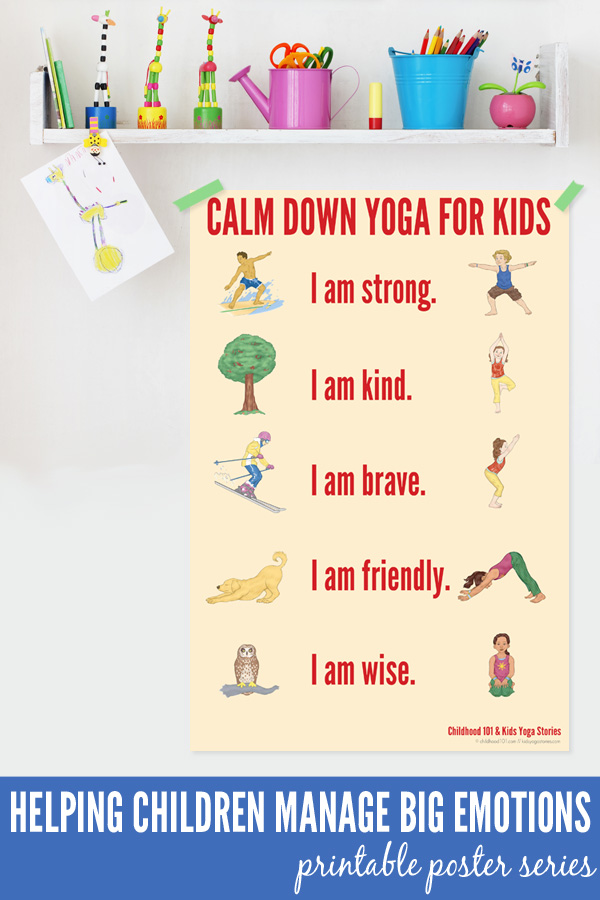
Imagine that your child has a friend over for a play date. They are busy playing together, when suddenly your child’s Lego structure gets knocked down. From your child’s facial expression, you see that she is about to explode. You catch her eye and give her the signal. Then she darts away to her “calm zone,” where you hear her counting down from five, while going through five yoga poses for kids. There’s a break of silence, and then after a little bit, your child comes back down to resume play. You look at each other and wink.
Sounds blissful, right? But it is possible. Helping children to regulate their emotions doesn’t necessarily happen overnight. Science tells us that the parts of the human brain that are critical to handling emotions aren’t fully developed until into we’re in our twenties, but we can take little steps when children are young to help them manage their feelings.
Brain research shows us that movement and breath help to alleviate stress and anxiety. Our bodies are designed to move—just think about how many miles a day the cave people used to run every day. Modern people lead mostly sedentary lives, and we almost have to relearn how to use movement to lead happy and healthy lives.
Don’t worry if your family hasn’t tried yoga before; use the images and descriptions below as a guide. Focus on using movement to invite calm, and don’t worry about practicing perfectly aligned poses. Ensure that your child has enough space to practice the poses so that they aren’t bumping heads or stubbing toes. And make sure that they are safe with their bodies. For example, they shouldn’t be trying to wrap themselves into pretzels or bending into deep back bends. Have them focus on gentle movement that feels comfortable. This process will help to increase their body awareness, too.
Introduce the idea of yoga and the yoga poses long before the tantrum starts, so you’ll be familiar with the routine when it’s time to take action. Your child will feed off your enthusiasm when you introduce this yoga-pose sequence. Explain that it’s good for their brain. Introduce the “Move to Calm” strategy when you are both in a good mood and connected with each other. You might find yourself practicing the yoga pose sequence to manage your own emotions, too!
As your child goes through the flow of these five yoga poses, he can pretend to be a surfer, tree, skier, dog, and owl. If he’s interested, he could also state the corresponding “I am…” statements. Once he is comfortable with the yoga-pose sequence, he can take a deep breath in and a deep breath out during each pose, to further help to calm his body and mind.
So let’s look at the Move to Calm strategy. Depending on the age and needs of your child, you might practice only one yoga pose (like Child’s Pose) and count down from five while in that pose. But let’s say your child is ready to choose five yoga poses. She could make up her own sequence by looking at our Yoga Poses for Kids page for inspiration or by following this yoga flow sequence.
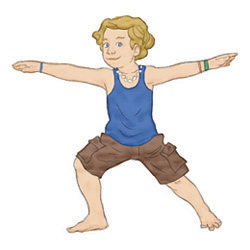 “I am strong.” Pretend to be a surfer.
“I am strong.” Pretend to be a surfer.
To do Warrior 2 Pose: From standing position, step one foot back, placing the foot so that it is facing slightly outwards. Take your arms up in parallel to the ground, bend your front knee, and look forward. Pretend to be a surfer and use your strength to catch tricky waves.
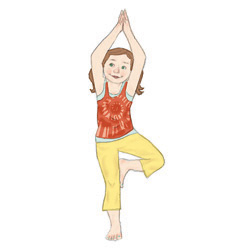 “I am kind.” Pretend to be a tree.
“I am kind.” Pretend to be a tree.
To do Tree Pose: Stand on one leg, bend your knee, place the sole of your foot on the opposite inner thigh, and balance. Sway like a tree. Think of trees being kind by offering shade, creating oxygen, and providing homes to animals.
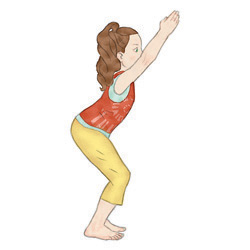 “I am brave.” Pretend to be a skier.
“I am brave.” Pretend to be a skier.
To do Chair Pose: Stand tall with your feet hip-width apart, bend your knees, and keep a straight spine. Hold your hands out in front of you, pretending to grasp ski poles as you fly down a ski run like a brave and fearless skier.
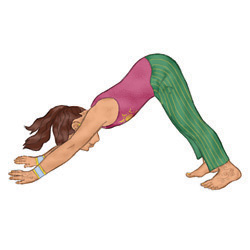 “I am friendly.” Pretend to be a dog.
“I am friendly.” Pretend to be a dog.
To do Downward-Facing Dog Pose: Bend down and place your palms flat on the ground. Step your feet back to create an upside-down V shape with your buttocks high in the air. Straighten your legs, relax your head and neck, and look down between your legs. Think of being an eager and friendly dog.
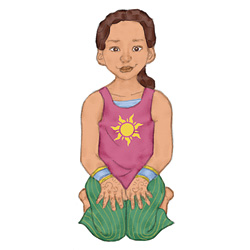 “I am wise.” Pretend to be an owl.
“I am wise.” Pretend to be an owl.
To do Hero Pose: Drop your knees to the ground and come down to rest upright on your heels. Then pretend to be a wise owl perched on a tree. Twist your upper body one way and then the other.
Start slowly and focus on your child’s success. If your child doesn’t click with using movement as a calming down strategy, don’t push it. Leave it for a while, and then try again. Just like every strategy, nothing is a one-size-fits-all solution, so feel free to adapt and change the yoga method to suit your child’s interests and needs. Introducing the idea of using movement and breath to help their brains to re-boot and re-focus is what’s important.
To download your poster: Click on your chosen poster image below – there are two versions for you to choose from. This will open a larger PDF version that you can download to your own computer. Open the PDF and print. When printing, select “Fit to printable area” (or similar) to ensure the page fits with your printer type and local paper size (these have been created at A4 size). I printed ours onto matte photo paper. Personal, non commercial use only.
A reminder: These posters are as much, if not more, for the parent or significant adult helping the child manage these emotions, as they are for the child. They are a tool to open discussion with your child about having a calm down plan and they can act as a visual prompt to help you (the adult) as you guide your child in that moment when they are struggling to manage. You know your child best and so while this process will work well for some children, it may not work for others. In the same way, their effectiveness will depend on the age and development of your child.
quoted from “https://childhood101.com/yoga-for-kids/”
I am joining my friends from Kid Blogger Network in a round up of topics interesting for parents and caregivers looking for fun activities to do with their kids. Since my 7 year old is very convinced that she will become an engineer, specifically, a mechanical engineer, I want to share 12 amazing engineering projects for kids from the blogosphere including, of course, ideas from this blog.
Disclosure: I am an Amazon associate, and this post contains Amazon affiliate links. For full disclosure, please click here, and thank you for supporting my blog!
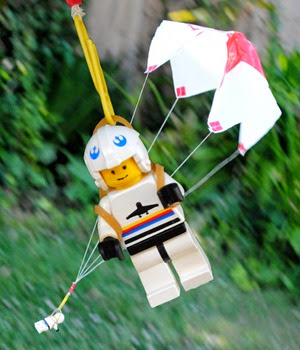
You can treat this project as an engineering challenge or follow an excellent toy parachute tutorial from Zakka Life. And check out this terrific round up of crafts that fly from The Pleasantest Thing.
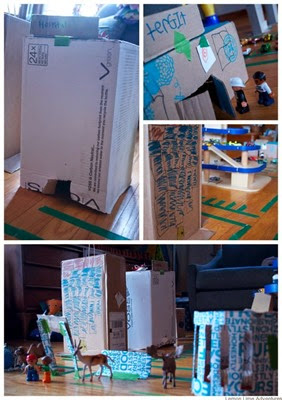
Cardboard is a cheap and easily available material for young engineers. Build a cardboard city from Lemon Lime Adventures or visit my blog buddy Mama Smiles: Joyful Parenting who guest posted on In the Playroom about 10 wondrous things one can do with cardboard boxes.
I like this “industrial strength” geoboard from Crayon Box Chronicles because my 7 year old can practice screwing bolts and then play with her new board. Definitely doing one this summer!
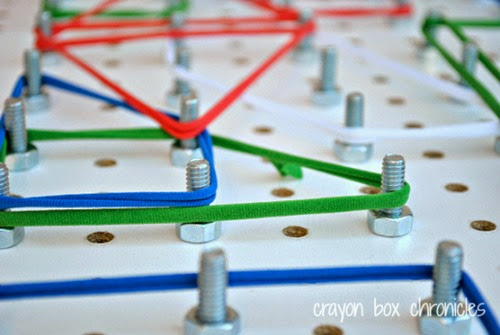
Everyone loves flinging objects across some distance, and there are several ways to build catapults including an open ended “engineering challenge” project. I like this simple catapult from Kids Activities Blog , and this post also contains links to more advanced catapult version.

Designing the boat that floats was the first engineering challenge for my 7 year old and her friend, and it was fun to see how they approached this task. Clearly, my daughter still needs to learn a lot before becoming an engineer.
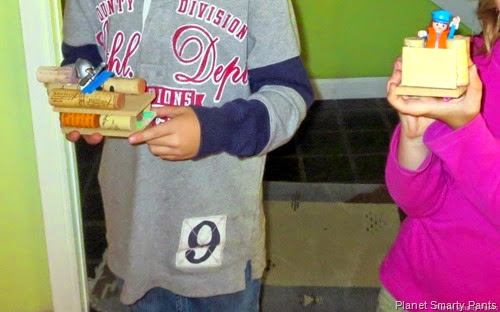
Testing different designs of airplanes is fun by itself, but Frugal Fun 4 Boys took it to the next level with a DIY paper airplane launcher.

Future engineers need to understand forces of nature. Science Sparks has a brilliant post about forces and a great project to go with it – a balloon powered Lego car.
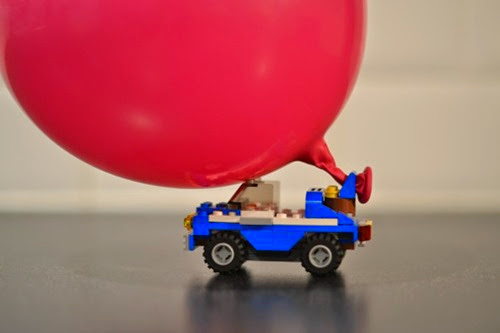
I pinned this propeller-powered car from Instructables as a potential summer project, but my daughter did something very similar this week in Camp Galileo (sponsored link), except her car their was driven by a sail.
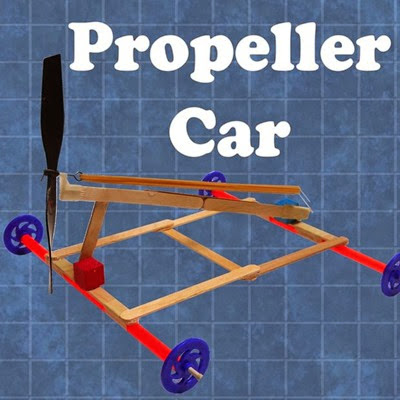
This was another engineering challenge that we had around Easter – first we made egg drivers and then each of us designed a race car for our drivers.. Of course, Papa’s car won!
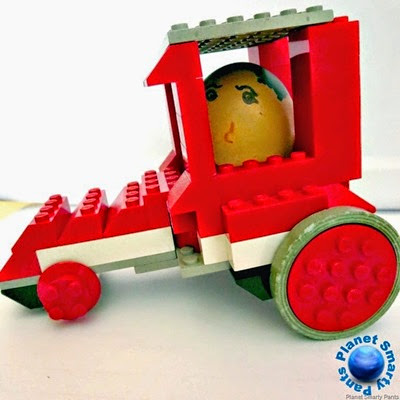
Robots hold endless fascination for future engineers. I am intrigued by this bristle bot from Evil Mad Scientist. I also highly recommend to check out this Really Rocking Robot Roundup from Brain Power Boy.

We have a marble run set, and Smarty enjoys trying out different configurations, but I still have a self-made marble run on the list of things to do. I love this simple DIY marble run from toilet paper rolls from TinkerLab, but Buggy and Buddy has a great round up of homemade marble run ideas to choose from.

Last, but not least Almost Unschoolers is a treasure trove of great ideas for older kids. She has several great ice architecture ideas including this Ice Cube Roman Arch.

quoted from “http://www.planetsmarty.com/2014/06/12-amazing-engineering-projects-for-kids.html”
1. Bir çalışmanın nasıl olması gerektiği konusundaki beklentilerinizi unutup, neyi nasıl kullanacağını çocuğunuzun kararına bırakın. (Yaratıcı düşüncenin esası olan keşfi engelleyen şey, anne babanın direktifleridir.)
2. Asla çocuğunuzun çalışmasına elinizi sürmeyin. (Çocuğun bir resmi kendi başına ortaya koyması, sizin resme yapacağınız katkıdan daha önemlidir.) Sizin müdahaleniz çocuğun cesaretini kırabilir.
3. Resimdeki tesadüfi şekilleri gerçek nesnelere benzetmeyin. (Bu, çalışmanın değerini yitirmesine yol açacaktır.)
4. Çocuğa “nasıl” çizmesi gerektiğini göstermeye kalkmayın ya da onun adına gerçek resimler çizmeyin. (Öğretmeye çalıştıklarınız, çocuğunuzun “keşfetmesini, yaratmasını” engeller nitelikte olabilir.)
5. Çocuğunuza asla “Bu ne?” ya da “Ne çiziyorsun?” gibi sorular sormayın. (Onun yaptığı şeyin nasıl olduğu, ne olduğundan daha önemlidir.)
6. Çocuğunuza asla boyama kitapları, kalıplar, çizim makineleri gibi sanatsal yaratıcılığı engelleyen oyuncaklar almayın. (Başkasının yarım bıraktığı bir şeyi tamamlamak çocuğunuz için herhangi bir yarar sağlamayacaktır.)
7. Asla çocuğunuzu resim yarışmalarına veya çocukları karşı karşıya getiren etkinliklere katılmaya yöneltmeyin. (Çocuklar için en faydalı olanı amaçlarını belirleyip kendi kendilerine yarışmalarıdır.)
8. Çocuğunuzu, tek doğru yanıtı bulmaya değil, çözüm olabilecek pek çok alternatif üretmeye yöneltin. (Gerçek yaşamda her sorunun tek bir çözümü yoktur. Sanat sorunları nasıl çözebileceklerini öğretir çocuklara.)
9. Uygun olmayan yüzeylere resim çizdiği için çocuğunuzu asla azarlamayın, ona kağıt verip “Güzel. Çizme isteğin kabardı anlaşılan,” deyin. (Her zaman olumlu tepkiler verin, çizim yapmak istediğini fark ettiğinizi vurgulayın mesela.)
10. Bir gelişim sürecini tamamlamadan diğerine geçmeye zorlamayın çocuğunuzu. (Her aşama önemlidir, birinden diğerine hızla geçmek yarardan çok zarar getirebilir.)
Etkinliğe ve yaşa göre düzenlenmiş “Sanatsal Gelişim Standartları”, çocuğunuzun gelişimini izlemede size rehber olabilir.
ÇİZİM
6-12 Ay : Tutar, bakar, pasteli ağzına götürür.
12-18 Ay :Karalama denemeleri yapar.
18-24 Ay : Yatay, dikey ve çapraz çizgiler çizer, karalama denemeleri yapar ve dokuyla ilgilenir.
24-30 Ay : Yuvarlak hatlı karalamalar yapar, değişik biçimler dener.
30-36 Ay : Çizgileri birleştirerek şekiller oluşturur ve bu şekiller adlandırır.
36-42 Ay : Resimleri hakkında öyküler anlatır, insan resimleri çizmeye başlayabilir.
6-12 Ay : Kile dokunur ve onun tadına bakar.
12-18 Ay : Kili çimdirir, sıkar ve koparır.
18-24 Ay : Yılan gibi şeritler yapar.
24-30 Ay : Kilden toplar yapar, objeleri adlandırır ve onlarla oynar.
30-36 Ay : Kili süslemeye, ona bir şeyler saplamaya başlar.
36-42 Ay : Kille tasarımlar yapar, yapılar kurar.
6-12 Ay : Boyayı ellerine sürer ve tadına bakar.
12-18 Ay : Vücudunu boyar, boyalı elleriyle şaplaklar atar.
18-24 Ay : Fırça ile karalamalar yapar, çizgiler çizer.
24-30 Ay : Karalamadaki gelişimine devam eder.
30-36 Ay : Yüzeyleri tümüyle boyamaya başlar.
36-42 Ay : Kağıdın tüm yüzeyini farklı boya tabakalarıyla kaplar.
http://www.egitimpedia. com’dan alıntıdır
Kaba Motor Becerisi Nedir?
Kaba motor becerisi, çocuğun büyük kas gruplarını kullandığı emeklemek, yürümek, zıplamak, dönmek ve denge gibi hareketlerin kontrolünün sağlanmasıdır. Çevreyi keşfetmek için ve belirli bir hareketi gerçekleştirmek için uyumlu hareketlerin koordine edilmesi için gereklidir.
0-1 Yaş Kaba Motor Gelişimi
1-2 Yaş Kaba Motor Gelişimi
2-3 Yaş Kaba Motor Gelişimi
3-6 Yaş Kaba Motor Gelişimi
Gelişmsel Uyarı İşaretleri
6 Ay Gelişim Uyarıları
12 Ay Gelişim Uyarıları
18 Ay Gelişim Uyarıları
2 Yaş Gelişim Uyarıları:
3-5 Yaş Gelişim Uyarıları:
Eğer çocuğunuz yaşıtlarına uygun kaba motor gelişimi göstermiyor ise çocuk doktorunuz ile görüşmenizi tavsiye ederim. Çalışmaya yılmadan devam.
http://cocuklaringelisimi.com ‘dan alıntıdır.

| Bazı çocuklar senden akıllı olabilir, Bazı çocukların senden güzel giysiler olabilir, Bazı çocuklar sporda ve sanatta senden daha iyi olabilirler, Bunları sorun etmemelisin! Senin de sana özgü özelliklerin var. Sen arkadaşlaryla en iyi anlaşan o çocuk olabilirsin, Sen o cömert çocuk olabilirsin, Sen başkaları için mutlu olabilen o çocuk olabilirsin, Sen doğru şeyi yapan o çocuk olabilirsin, Sen sadece kendini iyileştirerek çevreni güzelleştirebilirsin. Sen sadece iyi bir birey ol! |
 |